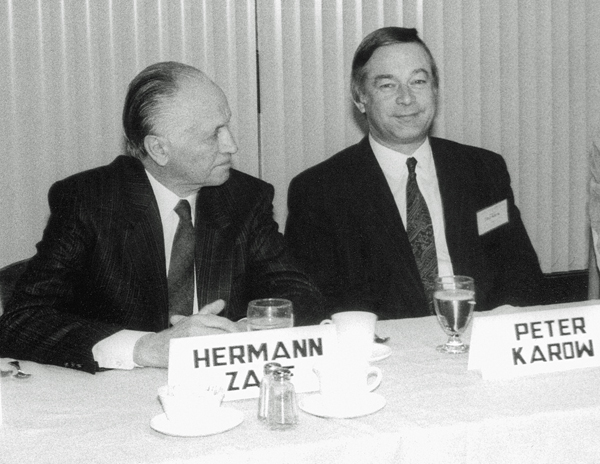Hermann Zapf (8 November 1918 – 4 June 2015)


The great calligraphy and type design master Hermann Zapf passed away yesterday, on 4 June 2015, at the age of 96. Hermann has been a defining force behind type design and typography in the 20th century.
His breathtaking calligraphic skills have impressed me first when I saw them in books, but impressed me even more when, ten years ago, at the age of 86, he casually took out his pencil and inscribed a few books for me. His typeface designs were simply beautiful, perhaps most importantly Optima, which has created an unmatched class of its own and stood for decades as an penultimate expression of letterform elegance.
But his contributions went way beyond that — Hermann Zapf served as typographic advisor to both Dr. Peter Karow (URW) and Professor Donald Knuth (TeX), the pioneers of computerized typography whose legacy we all benefit from today. Hermann had as much mastery in writing and drawing letters as he had in arranging them. The typographic arrangements that he devised are full of joy, beauty, balance and harmony — and deserve to be studied meticulously.
I had the great pleasure to work with Hermann on Zapfino Extra. I’ll always remember his quick wit, his friendliness, his open mind — regardless of his age. Thank you, Gudrun and Hermann, for the encouragement that you have given me in the early years of my typographic journey, and for the immense work that you have done for the beauty of letterforms. The word “legend” should be used sparsely, but Hermann Zapf definitely deserves it.
Comments
-
Zapf will surely be best known for Optima, Palatino, Zapfino, and even Dingbats, but I am personally a fan of his lesser known typefaces for ITC, like the squarish Book and groovy International, as well as the less flavorful but still masterful Comenius and Hunt Roman. So I guess what impressed me most about Zapf was his versatility. His diverse lettering showed it too:

Jean Giraudoux series, S.Fischer Verlag, 1961
Narziß und Goldmund (Narcissus and Goldmund) by Hermann Hesse, Suhrkamp, 1968
I love his steady, exacting hand, but I also love when he let loose.
Correction: this jacket was not by Zapf, who designed only the interior of the edition. Thanks to Jerry Kelly for the alert.
5 -
Palatino was my favorite font growing up on a black-and-white Mac... and I couldn't believe Zapfino when it was distributed with a later MacOS; it was the most beautiful thing I'd ever seen. Too bad everyone else thought so as well!
Nice lettering! I like that proud /g in "Krieg".
BTW, it's Goldmund, not -münd.
1 -
Thanks, Christian. I forgot that the mark is a ‘u’ distinguisher, not an umlaut.0
-
2
-
I remember in 1963, as a sophomore in design school at CMU, he came as a visiting lecturer in typography. He walked up to the black board and picked up a piece of chalk, broke it is half and began drawing with the side edge as if it were a flat pen. It took him three seconds to draw the most perfect double-bowled lowercase 'g' we had ever seen He gave an inspired lecture on pen angle and how strokes differ from calligraphy to typography. He skillfully drew chalk drawings of glyphs in several of his faces as examples instead of showing slides. He was very welcoming of our questions and helpful in reply. I treasure that memory still.9
-
Another eulogy at http://bazargan.org/a-tribute-to-hermann-zapf/3
-
I was probably around 15 when I learned there was such as thing as Melior. And I couldn't get over it. I thought: "You mean…people can do that? Just do it?"
For what little it's worth, I became a type designer because of Zapf. The first volume of his Manuale is what made type my religion. I bought my copy when I really didn't have money for that kind of thing, and I go back to it whenever I need to be reminded how beautiful a page can be.
I never met or even corresponded with him, and I don't really have a right to feel personally bereft, but I do. Olev hashalom.
5 -
Well said, @Adam%20Twardoch2
-
In the METAFONTbook (1986) there is a dedication by Dr. Knuth that says it all : ‘To Hermann Zapf: Whose strokes are the best.’
Hermann Zapf mastered all expects of type design and calligraphy, and he surely can be ranked among the absolute greatest in the history of type. His technical skills were unbelievable, but he was much more than a craftsman. Adam justly refers to his cooperation with Dr. Knuth and Dr. Karow. His early adopting of digital technology has always intrigued me. He worked for instance together with Dr. Knuth on the Euler types in Metafont and with Dr. Karow on the hz-engine, which was named after him. And you are all familiar with this paragraph-composition technology, because it was implemented by Adobe in InDesign in 1995.
The picture below shows Peter Karow and Hermann Zapf at the Rochester Institute of Technology in 1989. Dr. Karow sent it to me for the booklet Digital Typography & Artificial Intelligence, which was published roughly two years ago by Adobe and DTL on occasion of the presentation of the Dr. Peter Karow Award to Dr. Knuth.
6 -
It's hard to overstate how much we liked and admired Hermann Zapf. My term as president of Boston's Society of Printers, of which HZ had been a member since 1969, coincided with his 90th birthday. We celebrated the event in two ways: with a keepsake prepared by his longtime friend Carl Zahn, featuring a watercolor Hermann had made in 1944, when he was in a French prisoner-of-war hospital; and with the 2009 Dwiggins Lecture, an assessment of HZ's work by Matthew Carter and Jerry Kelly. (Carl Zahn, one of the first users and promoters of Zapf's types in the U.S., was scheduled to participate, but had to drop out on account of illness.)
In my introduction, I tried to imagine Carl's point of view, that of a rising American book designer working in the 1950s, marveling over the freshness of Palatino, Optima, and Michelangelo when they first became available here:
"While the early-20th century German antiquas often appeared foreign to Anglo-American eyes, with telltale artifacts of fraktur, Zapf got it right. To Americans, who would come to embrace Zapf warmly, the work represented the best German traits: knowledge, superb craftsmanship, and utility, but free of the nationalist tendencies that had, by then, fallen into bad repute. It must have made one think that the Marshall Plan was hard at work on the typographic front. And Zapf returned the affection, concentrating many of his efforts on America, becoming more than just a occasional visitor, teaching and working closely with mom-and-apple-pie outfits such as Hallmark Cards and Microsoft."
As always, I got a very nice note from Hermann, who never missed a chance to voice his appreciation.
"The Eternal Letter" contains what is very likely the last major essay published about Zapf's work during his lifetime. It's an assessment by Paul Shaw of his capital letters, mostly the typographic ones but also showing calligraphic examples. The essay concludes:
"Today, Palatino and Optima are, at best, taken for granted and, at worst, unfairly looked down upon. Nevertheless, in the span of a decade—from 1948, the year that Palatino was designed, to 1958, the year that Optima made its debut—Hermann Zapf managed to reinvent the classical Roman capital for the 20th century, sidestepping the revivalism of Renaissance types that dominated the fine printing movement, and challenging, with Optima, the neo-grotesques championed by the adherents of Swiss typographic modernism. It was a singular achievement that still resonates more than a half century later."
We don't know whether Hermann agreed or not, but gracious to the end, he sent Paul a note expressing his thanks. This time, it wasn't hand-written, but typed in Zapfino with a pen signature.
The world looks a good bit better for his having been here. We shall miss him.
 11
11 -
The user and all related content has been deleted.2
-
They will appear, soon enough. I sent Steve Heller a link to this thread, as he's a likely person to write it for the NY Times. The obits that appear quickly are those that were written in advance, awaiting only the details of death. (A curious way to know if you're important or not.) At the Times obituary bureau, all people are classified either as "Dead" or "Pre-Dead." Margalit Fox, the chief of obituaries there, wrote an interesting and amusing article about it not long ago:
http://www.nytimes.com/times-insider/2014/08/29/obituaries-for-the-pre-dead/
In a round of emails about Hermann's passing among some friends, Matthew Carter wrote something that I think really said it all:
"I remember that I heard many years ago that somebody asked Warren Beatty who was the best actor. His reply went something like: 'Well I'll tell you this, when Marlon Brando goes everybody else moves up one.' Last Thursday, in the world of type design, everybody else moved up one."
I think you'll be seeing this elsewhere, but remember that you read it here first.
6 -
The user and all related content has been deleted.0
-
Is the "p" in his name really silent (per nytimes obit)?0
-
Nope, and neither is its onset voiced. It's [tsapf]. Typical case of journalist phonetics.
0 -
Word that looks best in Zapf International and vice-versa: Afghanistan.
 1
1 -
Sad to hear of his passing - 96 is a great innings too. Palatino was and still is one of my favourite serifs in the toolbox, it was only the other day I was telling my wife how it was the the font of choice for my high school essays on my old PowerBook Duo!
RIP0 -

Always thought Zapfino was a classic typeface.0 -
The Hermann Hesse dust jacket is not be Hermann Zapf. HZ designed the book, but not the dust jacket.1
-
Thanks for the correction, Jerry! I read it was his cover but I guess someone was mislead by the book design credit and I passed on the misinformation.0
Categories
- All Categories
- 46 Introductions
- 3.9K Typeface Design
- 486 Type Design Critiques
- 563 Type Design Software
- 1.1K Type Design Technique & Theory
- 655 Type Business
- 859 Font Technology
- 29 Punchcutting
- 520 Typography
- 119 Type Education
- 324 Type History
- 77 Type Resources
- 112 Lettering and Calligraphy
- 33 Lettering Critiques
- 79 Lettering Technique & Theory
- 557 Announcements
- 94 Events
- 114 Job Postings
- 170 Type Releases
- 178 Miscellaneous News
- 276 About TypeDrawers
- 54 TypeDrawers Announcements
- 120 Suggestions and Bug Reports









